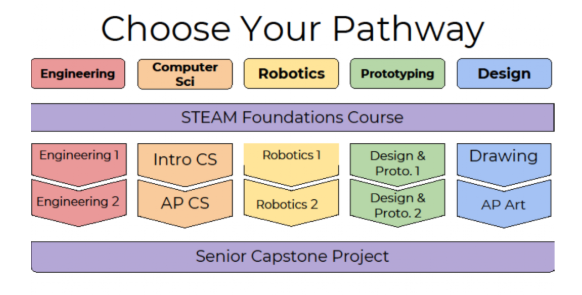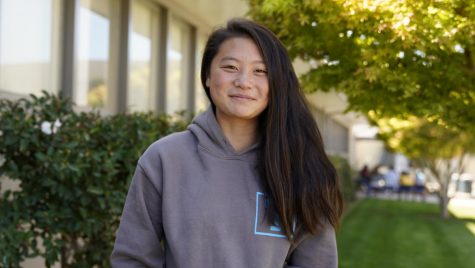Design and Fabrication pilot class to begin next year

Students who want to participate in the LAHS Academy of Engineering and Design must first complete the STEAM Foundations class. Afterward, they can choose one pathway to pursue to earn their remaining two year-long course credits.
February 3, 2019
Starting this upcoming school year, students can choose to take a new open-enrollment course called Design and Fabrication. Current Design and Prototyping and AP Statistics teacher Adam Anderson will teach this practical-art course, which incorporates large-scale, hands-on projects ranging from crafting instruments to building wind-powered kinetic walker sculptures.
Unlike Design and Prototyping, where the main focus is on formulating and modeling ideas, Design and Fabrication will involve simulating real-world working conditions and teaching students how to navigate through the manufacturing process.
“You start with an idea, but you can’t sell an idea,” Anderson said. “If you tell somebody else your idea, they can walk away with it. So, you need to build something with a proof of concept. But [we could also] design it into something something somebody else might want.”
The projects are meant to help students plan and design within given constraints, how to collaborate with others of diverse backgrounds and how to design products consumers would consider purchasing. Students will learn about the design process and effective marketing strategies but are also expected to research the science behind their creations. The projects are designed in a way to challenge students to push past their limits and discover what they are capable of achieving.
“There’s a basic level you have to you have to meet, but where can you take it from there?” Anderson said. “[The projects] could be amazing and astounding. [They have a] low floor [and a] high ceiling– [those are] the concepts world we’re trying for.”
Anderson also hopes to familiarize students with the various technological tools and hardware available at school. These include computer numerical control (CNC) routers, 3D printers, laser cutters and the lathe while also working with computer-aided-design (CAD) software.
While testing in Design and Fabrication will not be frequent, students are still required to pass safety tests to gain access to certain tools. This class is also homework-free, but students who are passionate about their project may choose to continue working outside of school hours. As a result, the workload in this class may vary based on each students’ commitment to the project.
“I grade based on effort and willingness to work with others,” Anderson said. “It’s not based on how good [you are] is compared to everybody [else]. We have students who come into [this] class with years of experience but we [also] have kids who’ve never seen a 3D printer and [have] barely [used] a computer at all.”
Design and Fabrication is a new addition to the LAHS Academy of Engineering and Design, a program run by teachers from various departments. Students can take the Design and Fabrication class along with the STEAM Foundations course—a one-year class consisting of cycling six-week learning periods in different subject classes— to earn one of two additional years of credit in either the engineering, art, computer science, design or robotics course pathways. Students who complete two years in one pathway plus STEAM Foundations would then be eligible to take the senior capstone course, a pilot class expected to open for the 2020-2021 school year. In the senior capstone course, students will collaborate and apply the skills they have learned from their past classes to solve a large-scale problem.
“[The senior capstone course is] like the senior thesis, but instead of doing a paper in English, it’ll be a year-long group project,” Anderson said. “People [with] all these different [skills will] group together, work together on a project [and will] have to write [their] own paper about the problem [they’re] trying to solve.”
A main goal of the LAHS Academy of Engineering and Design is to encourage students to practice fundamental skills needed in various different fields of occupations.
“The idea of history being [just] history and English being [just] English is [an] archaic [concept],” Anderson said. “In real jobs, you need the skills from all of these. We’re trying to create classes that use the skills learned in English [like] communications, research [in] history, math and science, and actually put them together with [the] hands-on creation of products.”
Anderson believes Design and Fabrication will be a perfect environment for students to formulate unrestrained ideas and push their limits.
“I want the students to push beyond the limitations of my creativity,” Anderson said. “[I want them to] take this as far as I can imagine, for as far as we can get with the materials and resources we have.”



